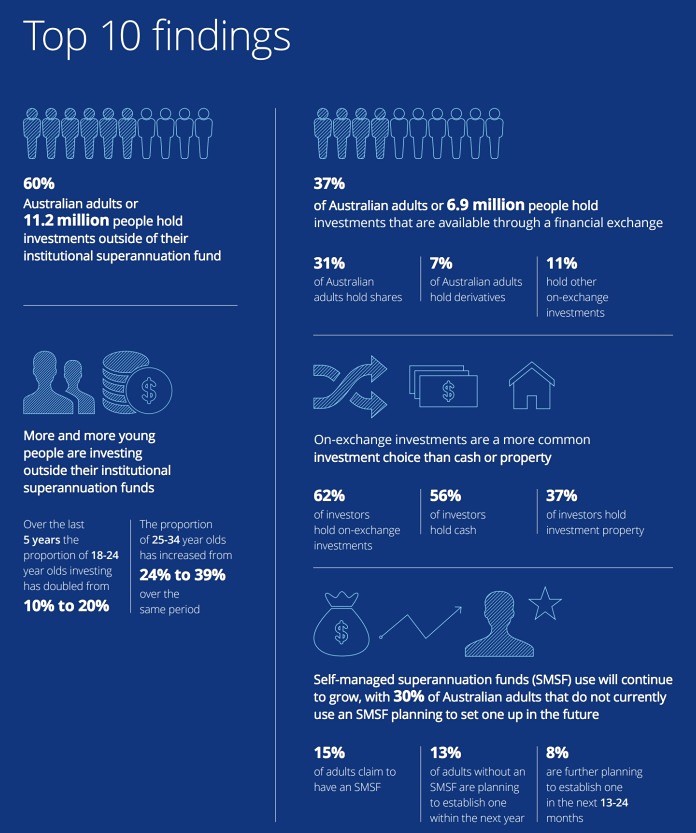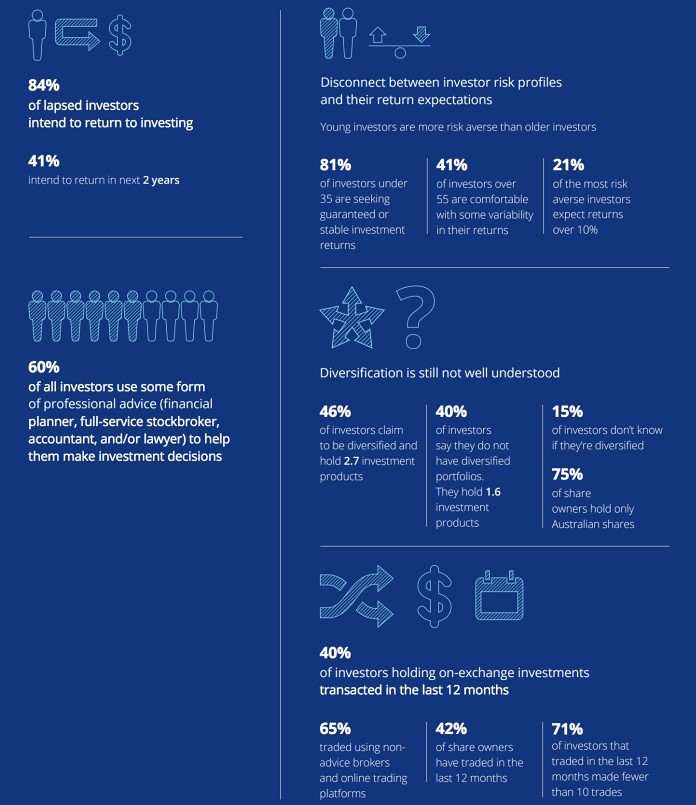Top 10 findings from the 2017 ASX Australian investor study

The 2017 ASX Australian investor study results were recently released, here are the top 10 findings from the report:
1 – 60% of Australian adults or 11.2 million people hold investments outside of their institutional superannuation fund.
2 – 37% of Australian adults or 6.9 million people hold investments that are available through a financial exchange.
3 – On-exchange investments are a more common investment choice than cash or property.
4 – More and more young people are investing outside their institutional superannuation funds; over the last 5 years the proportion of 18-24 year olds investing has double from 10% to 20%.
5 – Self managed superannuation funds use will continue to grow, with 30% of Australian adults that do not currently use an SMSF planning to set one up in the future.
6 – 84% of lapsed investors intend to return to investing with 41% intending to return in the next 2 years.
7 – 60% of all investors use some form of professional advice (financial planner, accountant, stockbroker, etc) to help them make investment decisions.
8 – Young investors are more risk averse than older investors. 81% of investors under 35 are seeking stable investment returns, while 41% of investors over 55 are comfortable with some variability in their returns and 21% of the most risk averse investors expect returns over 10%.
9 – Diversification is not well understood. 46% of investors claim to be diversified and hold 2.7 investment products, while 40% of investors say they do not have diversified portfolios, 15% of investors don’t know if they’re diversified and 75% of share owners hold only Australian shares.
10 – 40% of investors holding on-exchange investments transacted in the last 12 months.
A summary of the 2017 ASX Australian investor study
Investing is a critical activity in any modern economy. It’s how businesses prepare for serving customers in the future, how a nation grows over time, and how individuals and families can participate in financial successes of businesses and earn an income.
Investing is as old as economies themselves. And yet, the early Twenty-First Century is also a time of considerable change in the investment landscape. The changing structure of our population is reshaping who is investing and why. New digital technologies have brought new ways for people to invest, altered what they invest in, and how they receive advice.
In the aftermath of the global financial crisis and the European sovereign debt crisis, there has been a slowing of global growth and low nominal interest rates, which have contributed to lower yields and led to investors reconsidering their risk appetite. Over the past decade the Australian financial sector has been subject to significant policy change which has seen a tightening of regulation. This change continues to unfold and will impact the behaviours of financial intermediaries and investors.
In 2016, the Australian equity market generally outperformed other developed equity markets globally (RBA, 2017). At the time of writing, the S&P/ASX 200 was at its highest level since prior to the global financial crisis. Trading volumes have increased 23% over the 12 months to March, and continue to grow (ASX, 2017a). The domestic equity market capitalisation is at a historic high, reaching $1.8 trillion in March this year (ASX, 2017b).
At the same time, significant global events have influenced domestic markets over the last year. The announcements of decisions by British voters to leave the European Union and by US voters to elect President Trump coincided with increased trading volumes on ASX. These two largely unexpected developments are key examples of a global environment characterised by significant uncertainty. Geopolitical developments are likely to continue to be a focus for investors in the near future (Investment Magazine, 2017). Against this background, risk management will be an important consideration for all investors, increasing the importance of having an appropriately diversified portfolio.
This study does not provide an assessment about whether retail investors (hereafter referred to as ‘investors’) are doing the right thing, nor does it offer advice for these investors to follow. Instead, this study seeks to shed light on investor behaviour in this complex and changing investment landscape, and provides some ‘food for thought’ for the investment industry that caters to them.
This 2017 edition of the study has been prepared by Deloitte Access Economics, a successor to decades of effort by ASX, which has biennially published a profile of Australian share ownership since 1986. This study is based on an online survey of 4,000 individuals (a representative sample of the Australian adult population). The focus is on Australian adults that invest outside of their institutional superannuation fund arrangements.
The investment landscape has become more sophisticated over time, and while Australia has ranked well against global measures of financial literacy, there is scope to improve. Australian investors’ portfolios are not very diversified, and their awareness of financial products declines quickly outside of shares.
At the same time, the investment industry may not be engaging with investors as well as they could be. Some of the survey findings may challenge existing industry perceptions of investors. There is an opportunity for the industry to change and become more responsive to its customers, which can help deliver improved financial outcomes for Australians and the economy.


The full 2017 ASX Australian investor study report produced by Deloitte Access Economics can be found here.
